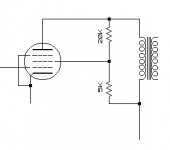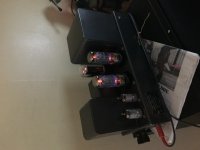I have just finished up a SE 807 using Blueglow's take on TriodeDicks SE 807. Amazing amplifier to my ears, no I haven't put it on scopes and all those thingamajigs. I have only listened to it through my Infinitys, from classical to metal to jazz etc. I cant say how deep I can the bass because my woofers are like 6" but its perfect for my needs. I ran two different sets of NOS Russian G807's and now I have NOS GE's in there, all sets are matched. For preamp and srpp I have Baldwin matched and balanced. Now I am on the hunt for a PP version and might go with Triode dicks version for this
Glad you liked it. I found it to be a lot of fun.
Mark
Mark
I have just finished up a SE 807 using Blueglow's take on TriodeDicks SE 807. Amazing amplifier to my ears, no I haven't put it on scopes and all those thingamajigs. I have only listened to it through my Infinitys, from classical to metal to jazz etc. I cant say how deep I can the bass because my woofers are like 6" but its perfect for my needs. I ran two different sets of NOS Russian G807's and now I have NOS GE's in there, all sets are matched. For preamp and srpp I have Baldwin matched and balanced. Now I am on the hunt for a PP version and might go with Triode dicks version for this
I`m listening to the amp now with 16K transformer,it sounds just fine....except the treble is to dark cymbals are to dark.and it was so with the 5k transformer.
It must be the driver tube 6J51P.
I thinking of changing to another driver so I have to rebuild the driver stage.
I have 3 tubes on my mind 6C45,5E6P and 6E6P,any one used one of those tubes to drive the 807and can recomend it.
It must be the driver tube 6J51P.
I thinking of changing to another driver so I have to rebuild the driver stage.
I have 3 tubes on my mind 6C45,5E6P and 6E6P,any one used one of those tubes to drive the 807and can recomend it.
Hi hermano, unfortunately Iam not able address your question, but Iam sure there is various experts here that will help you.Hi FullRangeMan
I have a SE Transformer without gap derivation.
Can i do a resistive divisor for simulate some NFB like UL Tap with 807 tube ?
I only have a pair of SE 2.5K:8Ohms without 43% tap derivation.
Stay home and be safe.
Can i do a resistive divisor for simulate some NFB like UL Tap with 807 tube ?
I only have a pair of SE 2.5K:8Ohms without 43% tap derivation.
AFAIUI the screen sees almost all the B+ with a convential 43% UL tap (since the DCR is low), but the signal is just 43% of the swing generated from the anode of the output tube.
You have a potential divider with 20% of B+ going to the screen, and also 20% of the swing being visible to the screen.
However, I'm not sure how having the resistor in parallel to the transformer impacts the calculation. I think the low DCR of the primary of the OPT will dominate, so minimal swing due to signal will be visible on the screen.
Hi FullRangeMan
I have a SE Transformer without gap derivation.
Can i do a resistive divisor for simulate some NFB like UL Tap with 807 tube ?
I only have a pair of SE 2.5K:8Ohms without 43% tap derivation.
You only need a mosfet to make it usefull, gate to resistor tap of divisor, drain to anode and source to grid 2. 😀
The new resistor divisor will be arrenged from actual anode to ground.
You need a low crss and high voltage N channel mosfet, to provide a low impedance and lower potential to grid 2 to archive better power capability, it will behave like a ultralinear stage, since the current of g2 will also travel trough the transformer, and it wouldnt be power limited like the previous set.
Watch out for the g2 dissipation you can also play with a series resistor to current limit g2.
Last edited:
AFAIUI the screen sees almost all the B+ with a convential 43% UL tap (since the DCR is low), but the signal is just 43% of the swing generated from the anode of the output tube.
You have a potential divider with 20% of B+ going to the screen, and also 20% of the swing being visible to the screen.
However, I'm not sure how having the resistor in parallel to the transformer impacts the calculation. I think the low DCR of the primary of the OPT will dominate, so minimal swing due to signal will be visible on the screen.
The resistive divider does not divide B+, but DC and AC voltages across the OT's primary instead. The drawbacks are that both resistors consume some part of the output power and that the screens look into a higher source impedance, compared with a tapped primary.
Best regards!
807's? Yeah, they were fun. In 1968.
Hell's the year got to do with it? Hollow state was "obsolete" in 1968, and moreso today. Still use hollow state though.
Can't say I'd bother with them now though.
Then more for me. 6L6-oids require a bit more attention for sonic excellence, but I still use 'em, at least for audio.
Valves were still quite popular in guitar amplifiers in 1968, but the 807 is from the '40s and was pretty much unused by then.
I built this Triode-connected 807 amplifier that year. But time marches on, and nostalgia ain't what it used to be.
I built this Triode-connected 807 amplifier that year. But time marches on, and nostalgia ain't what it used to be.
I built this Triode-connected 807 amplifier that year. But time marches on, and nostalgia ain't what it used to be.
That link was interesting - do you have any more pages?
From your comment, was it a disappointing end result?
I bought a job lot of 5B/255M (another repackaged 807 from the 50’s), and I have made octal adaptors for them, and am experimenting with using them where a 6L6GC could be used. So your views on the sound quality would be interesting!
I bought a job lot of 5B/255M (another repackaged 807 from the 50’s), and I have made octal adaptors for them, and am experimenting with using them where a 6L6GC could be used. So your views on the sound quality would be interesting!
Yeah, these are of superior construction, due to the lack of that old pinch stem. But they won't equal a 6L6GC, 'cause plate dissipation is lower.
Another more modern derivative is the 5933, which even features the UX-5 base, but also lacks the pinch stem.
Best regards!
Here they are, substituting for KT66 in a Quad 2. I am using a 5R4GYB rectifier, so B+ is reduced to 318v, and they are biased at 22.5v, with a separate cathode bias resistor of 390ohms. I’m wondering about the screens, which will be seeing nearly 300V. It is hard to work out if that is an issue because there are not a lot of data sheets for these tubes. They sound OK though!
Attachments
That link was interesting - do you have any more pages?
Sure do.
Circus diagram
Article page 3
Article page 4
From your comment, was it a disappointing end result?
Not really, it sounded quite good to my 15yo ears. But I made it from an old transmitter found at the local rubbish dump, so the cost was zero. Some guy walked into my parents' garage off the street and offered me money for it within days, so I sold it to buy a car.
However, these days the cost of building such a beastie is astronomical, and the results don't come near a D-class module you can get off eBay for peanuts.
I bought a job lot of 5B/255M (another repackaged 807 from the 50’s), and I have made octal adaptors for them, and am experimenting with using them where a 6L6GC could be used. So your views on the sound quality would be interesting!
Well, I guess the nostalgia just bit me in the ar5e. I bought seven NOS Australian Wireless Valve 807's last night. Gonna make me a pair of monoblocs, just for the halibut.
If you know the sound of a 6L6 then you won't be surprised at the result.
- Home
- Amplifiers
- Tubes / Valves
- 807 Sound Quality?

